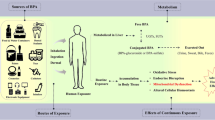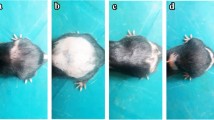Abstract
This study investigated the potential effects of China dust (CD) exposure on cyclophosphamide (CP)-induced testicular toxicity in mice, focusing on spermatogenesis and oxidative damage. CP treatment reduced testicular and epididymal weight and sperm motility and enhanced sperm abnormality. Histopathological examination presented various morphological alterations in the testis, including increased exfoliation of spermatogenic cells, degeneration of early spermatogenic cells, vacuolation of Sertoli cells, a decreased number of spermatogonia/spermatocytes/spermatids, along with a high number of apoptotic cells. In addition, the testis exhibited reduced glutathione (GSH) levels and glutathione reductase (GR) activity and enhanced malondialdehyde (MDA) concentration. Meanwhile, CD exposure exacerbated testicular histopathological alterations induced by CP. CD exposure also aggravated oxidative damage by increasing the lipid peroxidative product MDA and decreasing GSH levels and antioxidant enzyme activities in the testis. These results suggest that CD exposure exacerbates CP-induced testicular toxicity in mice, which might be attributed to the induction of lipid peroxidation and reduced antioxidant activity.



Similar content being viewed by others
References
Ahlmann M, Hempel G (2016) The effect of cyclophosphamide on the immune system: implications for clinical cancer therapy. Cancer Chemother Pharmacol 78:661–671. https://doi.org/10.1007/s00280-016-3152-1
Emadi A, Jones RJ, Brodsky RA (2009) Cyclophosphamide and cancer: golden anniversary. Nat Rev Clin Oncol 6:638–647. https://doi.org/10.1038/nrclinonc.2009.146
Ghobadi E, Moloudizargari M, Asghari MH, Abdollahi M (2017) The mechanisms of cyclophosphamide-induced testicular toxicity and the protective agents. Expert Opin Drug Metab Toxicol 13:525–536. https://doi.org/10.1080/17425255.2017.1277205
Das UB, Mallick M, Debnath JM, Ghosh D (2002) Protective effect of ascorbic acid on cyclophosphamide-induced testicular gametogenic and androgenic disorders in male rats. Asian J Androl 4:201–207. https://pubmed.ncbi.nlm.nih.gov/12364977/
Hoorweg-Nijman JJ, Delemarre-van de Waal HA, de Waal FC, Behrendt H (1992) Cyclophosphamide-induced disturbance of gonadotropin secretion manifesting testicular damage. Acta Endocrinol (Copenh) 126:143–148. https://doi.org/10.1530/acta.0.1260143
Ghosh D, Das UB, Ghosh S, Mallick M (2002) Testicular gametogenic and steroidogenic activities in cyclophosphamide treated rat: a correlative study with testicular oxidative stress. Drug Chem Toxicol 25:281–292. https://doi.org/10.1081/dct-120005891
Liu F, Li XL, Lin T, He DW, Wei GH et al (2012) The cyclophosphamide metabolite, acrolein, induces cytoskeletal changes and oxidative stress in Sertoli cells. Mol Biol Rep 39:493–500. https://doi.org/10.1007/s11033-011-0763-9
Haenen GR, Vermeulen NP, Tai-Tin-Tsoi JN, Ragetli HM, Timmerman H et al (1988) Activation of the microsomal glutathione-S-transferase and reduction of the glutathione dependent protection against lipid peroxidation by acrolein. Biochem Pharmacol 37:1933–1938. https://doi.org/10.1016/0006-2952(88)90539-4
Kim SH, Lee IC, Ko JW, Shin IS, Moon C et al (2016) Mechanism of protection by diallyl disulfide against cyclophosphamide-induced spermatotoxicity and oxidative stress in rats. Mol Cell Toxicol 12:301–312. https://doi.org/10.1007/s13273-016-0035-9
Ertmer F, Oldenhof H, Schütze S, Rohn K, Wolkers WF et al (2017) Induced sub-lethal oxidative damage affects osmotic tolerance and cryosurvival of spermatozoa. Reprod Fertil 29:1739–1750. https://doi.org/10.1071/RD16183
Kim K, Kim SD, Shin TH, Bae CS, Ahn T et al (2021) Respiratory and systemic toxicity of inhaled artificial Asian sand dust in pigs. Life (Basel) 11:25. https://doi.org/10.3390/life11010025
Hashizume M, Kim Y, Ng CFS, Chung Y, Madaniyazi L et al (2020) Health effects of Asian dust: a systematic review and meta-analysis. Environ Health Perspect 128:66001. https://doi.org/10.1289/EHP5312
Cheung K, Daher N, Kam W, Shafer MM, Ning Z et al (2011) Spatial and temporal variation of chemical composition and mass closure of ambient coarse particulate matter (PM10–2.5) in the Los Angeles area. Atmos Environ 45:2651–2662. https://doi.org/10.1016/j.atmosenv.2011.02.066
Mori I, Nishikawa M, Tanimura T, Quan H (2003) Change in size distribution and chemical composition of kosa (Asian dust) aerosol during long-range transport. Atmos Environ 37:4253–4263. https://doi.org/10.1016/S1352-2310(03)00535-1
Gualtieri M, Ovrevik J, Mollerup S, Asare N, Longhin E et al (2011) Airborne urban particles (Milan winter-PM2.5) cause mitotic arrest and cell death: effects on DNA, mitochondria, AhR binding and spindle organization. Mutat Res 713:18–31. https://doi.org/10.1016/j.mrfmmm.2011.05.011
Øvrevik J (2019) Oxidative potential versus biological effects: a review on the relevance of cell-free/abiotic assays as predictors of toxicity from airborne particulate matter. Int J Mol Sci 20:4772. https://doi.org/10.3390/ijms20194772
Li N, Xia T, Nel AE (2008) The role of oxidative stress in ambient particulate matter-induced lung diseases and its implications in the toxicity of engineered nanoparticles. Free Radic Biol Med 44:1689–1699. https://doi.org/10.1016/j.freeradbiomed.2008.01.028
Møller P, Danielsen PH, Karottki DG, Jantzen K, Roursgaard M et al (2014) Oxidative stress and inflammation generated DNA damage by exposure to air pollution particles. Mutat Res Rev Mutat Res 762:133–166. https://doi.org/10.1016/j.mrrev.2014.09.001
NRC (National Research Council) (2011) Guide for the Care and Use of Laboratory Animals. National Research Council, National Academy, Washington, USA
Lee KH, Lee DW, Kang BC (2020) The ‘R’ principles in laboratory animal experiments. Lab Anim Res 36:45. https://doi.org/10.1186/s42826-020-00078-6
Abd-El-Tawab AM, Shahin NN, AbdelMohsen MM (2014) Protective effect of Satureja montana extract on cyclophosphamide-induced testicular injury in rats. Chem Biol Interact 224:196–205. https://doi.org/10.1016/j.cbi.2014.11.001
Chabra A, Shokrzadeh M, Naghshvar F, Salehi F, Ahmadi A (2014) Melatonin ameliorates oxidative stress and reproductive toxicity induced by cyclophosphamide in male mice. Hum Exp Toxicol 33:185–195. https://doi.org/10.1177/0960327113489052
Ko JW, Shin NR, Je-Oh L, Jung TY, Moon C et al (2020) Silica dioxide nanoparticles aggravate airway inflammation in an asthmatic mouse model via NLRP3 inflammasome activation. Regul Toxicol Pharmacol 112:104618. https://doi.org/10.1016/j.yrtph.2020.104618
Park EJ, Kang MS, Jin SW, Lee TG, Lee GH et al (2021) Multiple pathways of alveolar macrophage death contribute to pulmonary inflammation induced by silica nanoparticles. Nanotoxicology 15:1087–1101. https://doi.org/10.1080/17435390.2021.1969461
Lee KM, Lee IC, Kim SH, Moon C, Park SH et al (2012) Melatonin attenuates doxorubicin-induced testicular toxicity in rats. Andrologia 44:796–803. https://doi.org/10.1111/j.1439-0272.2011.01269.x
Beladiya JV, Mehta AA (2021) Acute and 28-days subacute toxicity studies of Gαq-RGS2 signaling inhibitor. Lab Anim Res 37:17. https://doi.org/10.1186/s42826-021-00093-1
Jeong YJ, Jeon H, Kim EJ, Ryu HY, Song KS et al (2022) Evaluation of the acute, sub-chronic and chronic oral toxicity, genetic toxicity, and safety of a Lomens-Po. Toxicol Res 38:69–90. https://doi.org/10.1007/s43188-021-00090-5
Oakberg EF (1956) A description of spermiogenesis in the mouse and its use in analysis of the cycle of the seminiferous epithelium and germ cell renewal. Am J Anat 99:391–413. https://doi.org/10.1002/aja.1000990303
Yang HW, Park JH, Shin JM, Lee HM, Park IH (2019) Asian sand dust upregulates IL-6 and IL-8 via ROS, JNK, ERK, and CREB signaling in human nasal fibroblasts. Am J Rhinol Allergy 34:249–261. https://doi.org/10.1177/1945892419890267
Lim JO, Lee SJ, Kim WI, Pak SW, Kim JC et al (2021) Melatonin alleviates silica nanoparticle-induced lung inflammation via thioredoxin-interacting protein downregulation. Antioxidants 10:1765. https://doi.org/10.3390/antiox10111765
Kim SH, Lee IC, Baek HS, Moon C, Kim SH et al (2013) Protective effect of diallyl disulfide on cyclophosphamide-induced testicular toxicity in rats. Lab Anim Res 29:204–211. https://doi.org/10.5625/lar.2013.29.4.204
Tripathi DN, Jena GB (2008) Astaxanthin inhibits cytotoxic and genotoxic effects of cyclophosphamide in mice germ cells. Toxicology 248:96–103. https://doi.org/10.1016/j.tox.2008.03.015
Ilbey YO, Ozbek E, Simsek A, Otunctemur A, Cekmen M et al (2009) Potential chemoprotective effect of melatonin in cyclophosphamide- and cisplatin-induced testicular damage in rats. Fertil Steril 92:1124–1132. https://doi.org/10.1016/j.fertnstert.2008.07.1758
Yoshida S, Hiyoshi K, Ichinose T, Nishikawa M, Takano H et al (2009) Aggravating effect of natural sand dust on male reproductive function in mice. Reprod Med Biol 8:151–156. https://doi.org/10.1007/s12522-009-0027-8
Yoshida S, Ichinose T, Arashidani K, He M, Takano H et al (2016) Effects of fetal exposure to Asian sand dust on development and reproduction in male offspring. Int J Environ Res Public Health 13:1173. https://doi.org/10.3390/ijerph13111173
Liu B, Wu SD, Shen LJ, Zhao TX, Wei Y et al (2019) Spermatogenesis dysfunction induced by PM2.5 from automobile exhaust via the ROS-mediated MAPK signaling pathway. Ecotoxicol Environ Saf 167:161–168. https://doi.org/10.1016/j.ecoenv.2018.09.118
Sikka SC (2004) Role of oxidative stress and antioxidants in andrology and assisted reproductive technology. J Androl 25:5–18. https://doi.org/10.1002/j.1939-4640.2004.tb02751.x
Palani AF (2018) Effect of serum antioxidant levels on sperm function in infertile male. Mid East Fertil Soc J 23:19–22. https://doi.org/10.1016/j.mefs.2017.07.006
Motawi TM, Sadik NA, Refaat A (2010) Cytoprotective effects of DL-alpha-lipoic acid or squalene on cyclophosphamide-induced oxidative injury: an experimental study on rat myocardium, testicles and urinary bladder. Food Chem Toxicol 48:2326–2336. https://doi.org/10.1016/j.fct.2010.05.067
Liu J, Zhang J, Ren L, Wei J, Zhu Y et al (2019) Fine particulate matters induce apoptosis via the ATM/P53/CDK2 and mitochondria apoptosis pathway triggered by oxidative stress in rat and GC-2spd cell. Ecotoxicol Environ Saf 180:280–287. https://doi.org/10.1016/j.ecoenv.2019.05.013
Wei Y, Cao XN, Tang XL, Shen LJ, Lin T et al (2018) Urban fine particulate matter (PM2.5) exposure destroys blood-testis barrier (BTB) integrity through excessive ROS-mediated autophagy. Toxicol Mech Methods 28:302–319. https://doi.org/10.1080/15376516.2017.1410743
Wang L, Luo D, Liu X, Zhu J, Wang F et al (2021) Effects of PM2.5 exposure on reproductive system and its mechanisms. Chemosphere 264:128436. https://doi.org/10.1016/j.chemosphere.2020.128436
Kaczanowski S (2016) Apoptosis: its origin, history, maintenance and the medical implications for cancer and aging. Phys Biol 13:031001. https://doi.org/10.1088/1478-3975/13/3/031001
Guo H, Ouyang Y, Wang J, Cui H, Deng H et al (2021) Cu-induced spermatogenesis disease is related to oxidative stress-mediated germ cell apoptosis and DNA damage. J Hazard Mater 416:125903. https://doi.org/10.1016/j.jhazmat.2021.125903
Shukla KK, Mahdi AA, Rajender S (2012) Apoptosis, spermatogenesis and male infertility. Front Biosci (Elite Ed) 4:746–754. https://doi.org/10.2741/415
Boekelheide K (2005) Mechanisms of toxic damage to spermatogenesis. J Natl Cancer Inst Monogr 34:6–8. https://doi.org/10.1093/jncimonographs/lgi006
Cai L, Hales BF, Robaire B (1997) Induction of apoptosis in the germ cells of adult male rats after exposure to cyclophosphamide. Biol Reprod 56:1490–1497. https://doi.org/10.1095/biolreprod56.6.1490
Acknowledgements
The authors would like to thank the researchers at Korea Institute of Toxicology for their technical support.
Funding
This work was supported by the National Research Foundation of Korea (NRF) grant funded by the Korea Government (MSIT) (NRF-2020R1A4A1019395). This work was also supported by the National Research Foundation of Korea (NRF) grant funded by the Korea government (MSIT) (NRF- 2021R1A2C2011673).
Author information
Authors and Affiliations
Contributions
Conceptualization, writing-original draft, and validation: WIK and JOL; Investigation and formal analysis: SWP; Data curation: SJL; Methodology, software, and visualization: ISS; Writing-editing and review: CM, and JDH; supervision and funding acquisition: JCK. All authors have read and agreed to the published version of the manuscript.
JDH and JCK mainly designed the study. WIK and JOL performed the experiments. WIK, SWP and SJL analyzed the experimental results. WIK wrote the paper. ISS, CM, JDH and JCK assisted the crucial revision of drafts. All authors read and approved the final manuscript.
Corresponding author
Ethics declarations
Competing interests
The authors have no relevant financial or non-financial interests to disclose.
Ethics approval
The experimental protocol was performed in accordance with the protocol of the CNU Institutional Animal care and Use Committee (CNU IACUC-YB-2020-109).
Consent to participate
Informed consent was obtained from all individual participants included in the study.
Additional information
Publisher’s Note
Springer Nature remains neutral with regard to jurisdictional claims in published maps and institutional affiliations.
Rights and permissions
Springer Nature or its licensor holds exclusive rights to this article under a publishing agreement with the author(s) or other rightsholder(s); author self-archiving of the accepted manuscript version of this article is solely governed by the terms of such publishing agreement and applicable law.
About this article
Cite this article
Kim, WI., Lim, JO., Pak, SW. et al. Exposure to China dust exacerbates testicular toxicity induced by cyclophosphamide in mice. Toxicol Res. 39, 115–125 (2023). https://doi.org/10.1007/s43188-022-00149-x
Received:
Revised:
Accepted:
Published:
Issue Date:
DOI: https://doi.org/10.1007/s43188-022-00149-x




